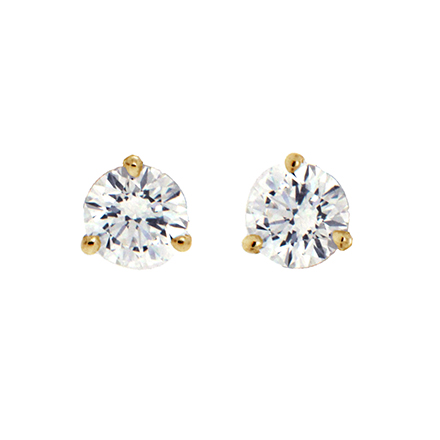The answer to the easiest way to accessorize any outfit is diamonds, and when the question lingers on to what kind of jewelry, the answer is a pair of sparkling, timeless, diamond studs. Nothing brings an outfit alive or puts an attire together than a pair of brilliant diamond earrings. Diamond studs are one of the most versatile pieces in the jewelry collection. They are the classics in earrings, the set you cannot afford to not own, quite like the little black dress.
 Three Point Setting: The three prong setting is a relatively new style and have been specifically crafted to fit round and triangular diamonds in studs. Not unlike four point setting, in this, three claws hold the stone from three directions, securing it strongly to the seat while creating three points of metallic glint around it.
Three Point Setting: The three prong setting is a relatively new style and have been specifically crafted to fit round and triangular diamonds in studs. Not unlike four point setting, in this, three claws hold the stone from three directions, securing it strongly to the seat while creating three points of metallic glint around it.
Four Prong Setting: This is perhaps the most common design in diamond solitaires. Four prong settings are not different than the one mentioned above, except that it is used to secure princess cut diamonds. However, the bottom of a four prong setting is slightly different, in that it has a basket-style bottom that gives the stone a gentle elevation and a pocket adequately sized to set its diving culet in its hollow.
Six Prong Setting: Six prong settings are often favored over three and four-prong styles because of their better hold over the stone. Aside better security, the setting brings with it the advantage of a more symmetrical and rounder appearance. It is used to secure round-cut diamonds. The more number of claws accent the stones sharply with metallic claws.
Bezel Setting: Bezel setting is perhaps the most easily likeable of them all. It’s a pretty rounded and smooth setting with no claws, but a full round bracket that clasps the stone from all sides, seating it smugly inside the contour. There is a greater guarantee of security with bezel setting than any other. The claws may accidentally shear off, but the bezel side is difficult to damage without intentionally trying to rip it off.
Halo Setting: Last but not the least is the halo setting. This setting is not essentially for solitaire studs because the halos, more often than not carry a good number of smaller stones that accent the focal gem. A halo uses pave setting for the border.





